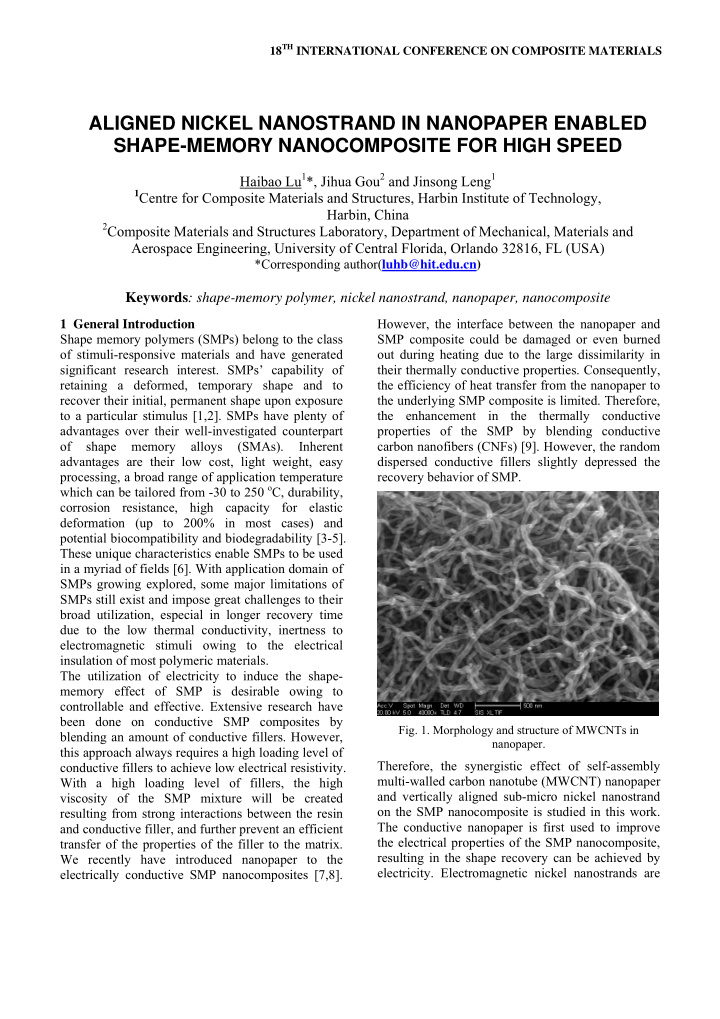



18 TH INTERNATIONAL CONFERENCE ON COMPOSITE MATERIALS ALIGNED NICKEL NANOSTRAND IN NANOPAPER ENABLED SHAPE-MEMORY NANOCOMPOSITE FOR HIGH SPEED Haibao Lu 1 *, Jihua Gou 2 and Jinsong Leng 1 1 Centre for Composite Materials and Structures, Harbin Institute of Technology, Harbin, China 2 Composite Materials and Structures Laboratory, Department of Mechanical, Materials and Aerospace Engineering, University of Central Florida, Orlando 32816, FL (USA) *Corresponding author( luhb@hit.edu.cn) Keywords : shape-memory polymer, nickel nanostrand, nanopaper, nanocomposite However, the interface between the nanopaper and 1 General Introduction Shape memory polymers (SMPs) belong to the class SMP composite could be damaged or even burned of stimuli-responsive materials and have generated out during heating due to the large dissimilarity in significant research interest. SMPs’ capability of their thermally conductive properties. Consequently, retaining a deformed, temporary shape and to the efficiency of heat transfer from the nanopaper to recover their initial, permanent shape upon exposure the underlying SMP composite is limited. Therefore, to a particular stimulus [1,2]. SMPs have plenty of the enhancement in the thermally conductive advantages over their well-investigated counterpart properties of the SMP by blending conductive of shape memory alloys (SMAs). Inherent carbon nanofibers (CNFs) [9]. However, the random advantages are their low cost, light weight, easy dispersed conductive fillers slightly depressed the processing, a broad range of application temperature recovery behavior of SMP. which can be tailored from -30 to 250 o C, durability, corrosion resistance, high capacity for elastic deformation (up to 200% in most cases) and potential biocompatibility and biodegradability [3-5]. These unique characteristics enable SMPs to be used in a myriad of fields [6]. With application domain of SMPs growing explored, some major limitations of SMPs still exist and impose great challenges to their broad utilization, especial in longer recovery time due to the low thermal conductivity, inertness to electromagnetic stimuli owing to the electrical insulation of most polymeric materials. The utilization of electricity to induce the shape- memory effect of SMP is desirable owing to controllable and effective. Extensive research have been done on conductive SMP composites by Fig. 1. Morphology and structure of MWCNTs in blending an amount of conductive fillers. However, nanopaper. this approach always requires a high loading level of Therefore, the synergistic effect of self-assembly conductive fillers to achieve low electrical resistivity. multi-walled carbon nanotube (MWCNT) nanopaper With a high loading level of fillers, the high and vertically aligned sub-micro nickel nanostrand viscosity of the SMP mixture will be created on the SMP nanocomposite is studied in this work. resulting from strong interactions between the resin The conductive nanopaper is first used to improve and conductive filler, and further prevent an efficient the electrical properties of the SMP nanocomposite, transfer of the properties of the filler to the matrix. resulting in the shape recovery can be achieved by We recently have introduced nanopaper to the electricity. Electromagnetic nickel nanostrands are electrically conductive SMP nanocomposites [7,8].
then blended with and, vertically aligned into the SMP resin in a magnetic field, to improve the thermal conductivity. The vertically aligned nickel nanostrands will facilitate the heat transfer from the nanopaper to the underlying SMP nanocomposite to effectively accelerate the electro-active recovery behavior. The morphology and network structure of MWCNT nanopaper were characterized by scanning electron microscope (SEM, ZIESS Ultra-55) at 20 kV. Figure 1 is typical surface views of raw MWCNT arrays about 500 nm. There is no large particle that came from the aggregates can be found, owing to MWCNTs being well dispersed in the suspension. The image evidenced an individual MWCNT with a diameter of 10 to 20 nm, and length Fig. 3. Morphology and structure of aligned nickel of 1-15 μ m. It is observed the multiscale porous nanostrands in aSMP resin . structure of nanopaper, and the porous structure with average pore size of 50 to 1000 nm. Based on the 2 Experimental The MWCNTs (L-MWNT-1020) were received in SEM observation, it is found that individual powder from Shenzhen Nanometer Gang Co., Ltd, nanotube gather together to form bundles (ropes). China. The nanotubes are synthesized by chemical They are mostly arranged in ropes or bundles with vapor deposition (CVD) and have a purity of 95%. close-packed stacking. And a network structure is The nanotube has an out diameter of 10 to 20 nm formed by molecular interaction and mechanical and 1-15 μ m in length. The non-ionic surfactant interlocking among nanotubes. Such a continuous network will act as a conductive path for electrons, (Triton X-100, C 14 H 22 O(C 2 H 4 O) n ), has a hydrophilic making the nanopaper and its enabled polyethylene oxide group and a hydrophobic group. nanocomposite electrically conductive. Figure 2 The Triton X-100 has 9.5 ethylene oxide units on shows the nickel nanostrands were vertically aligned average. The hydrophobic group of surfactant in the SMP resin by a magnetic field. At the same backbone is close contact with the MWCNTs, time, the morphology and structure of aligned in the resulting in the modified MWCNTs having a SMP resin at the scale of 10 μ m is presented in the hydrophilic polyethylene oxide group. Therefore, this non-ionic surfactant will improve the dispersion Figure 3. of MWCNT in aqueous solution. The MWCNT suspension was sonicated with a high-intensity sonicator (MISONIX Sonicator 4000, Qsonica, LLC, Newtown, Connecticut, USA) at room temperature for 30 min. The MWCNT suspension was sonicated with a high-intensity sonicator with ultrasound power level of 420W. Two duty cycles were used for the dispersion of the MWCNT. After the initial 15 min sonication, both MWCNT suspension and probe were cooled back to room temperature. The sonication was carried out again for another 15 min under the same condition. The MWCNT suspension was then membrane filtrated under a positive pressure to yield uniform nanopapers. After the filtration, the MWCNT nanopaper was dried in a Fig. 2. Nickel nanostrands are aligned in a magnetic field. heating oven at 120 o C for 2 h to further remove the remaining water and surfactant. Nanopapers with
Recommend
More recommend